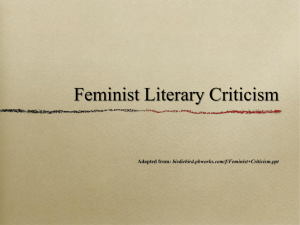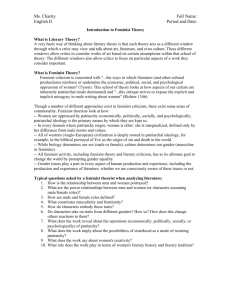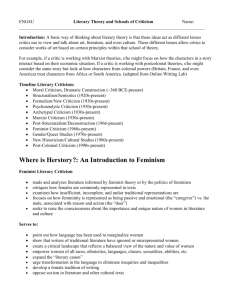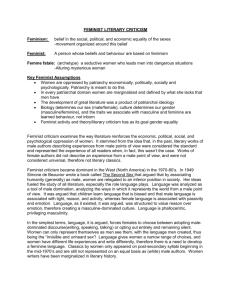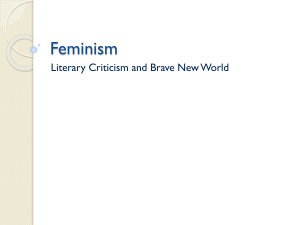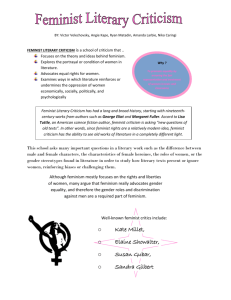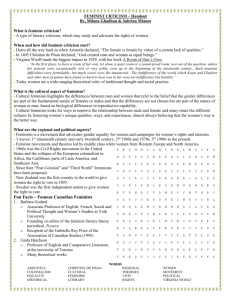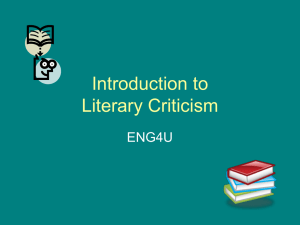Feminist Criticism
advertisement
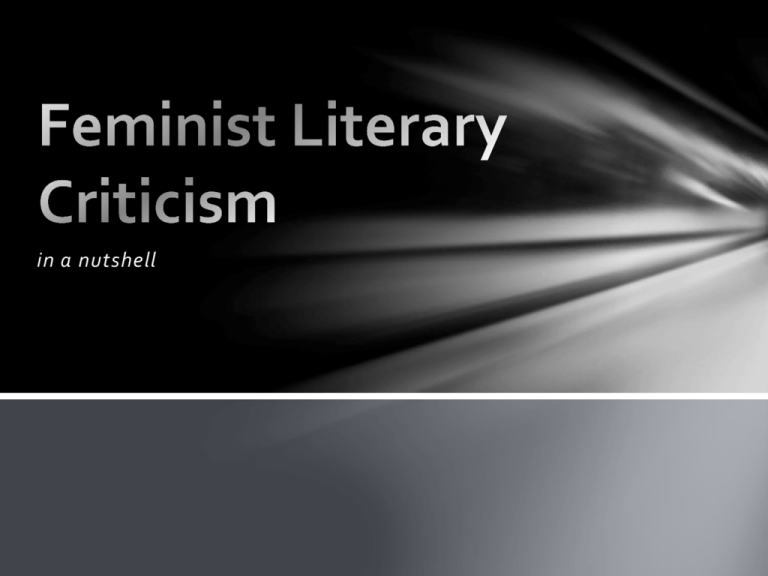
in a nutshell What is Literary Criticism? Definition: “establishment of principles governing literary composition, and the assessment and interpretation of literary works” (Norton 315). Basically: Literary theories are the “different lenses critics use to view and talk about art, literature, and even culture” and when we use those lenses, we base our views on background ideas with the school of theory that we are using (“Literary”). Norton, Anne-Lucie, ed. “Literary Criticism." Dictionary of Ideas. London: Brockhampton, 1994. 315. Print. “Literary Theory and Schools of Criticism." OWL: Purdue Online Writing Lab. Purdue University, 2016. Web. 13 Jan. 2016. So, how do we define Feminist Criticism? “Set of literary theories concerned with women as readers and writers of literary texts and as characters within them. Issues addressed include whether a specifically female writing exists, the way male authors perpetuate patriarchal attitudes through their writing, and the rehabilitation of neglected female authors” (Norton 195). Norton, Anne-Lucie, ed. "Feminist Criticism." Dictionary of Ideas. London: Brockhampton, 1994. 195. Print. Useful Secondary Definitions Patriarchy—used among feminist critics, referring to traditional male-dominated society. Marginalization—refers to being forced to the outskirts of what is considered socially and politically significant; the female voice was traditionally marginalized, or discounted altogether. Delahoyde, Michael. "Feminist Criticism." Feminist Criticism. Washington State Univ., 6 Jan. 2011. Web. 13 Jan. 2016. The Three Waves of Feminism Background: 1. First Wave Feminism—late 1700s to early 1900s 1. Highlights the inequalities between the sexes 2. Contributed to women’s suffrage movement 2. Second Wave Feminism—early 1960s to late 1970s 1. Built on more equal working conditions during WWII 2. Increased visibility for feminist political activism 3. Established groundwork for the dissemination of feminist theories 3. Third Wave Feminism—early 1990s to present 1. Spread focus beyond ideologies and white, heterosexual, middle class women 2. Borrows from contemporary gender and race theories 3. Expand on marginalized populations’ experiences Feminist Literary Criticism—Quickly Questions to ask about a text and/or character: • How is the relationship between men and women portrayed? • What are the power relationships between men and women (or characters assuming male/female roles)? • How are male and females roles defined? • What constitutes masculinity and femininity? • Do characters take on traits from opposite genders? How so? How does this change others’ reactions to them? • What does the work reveal about the operations (economically, politically, socially, or psychologically) of patriarchy? • What does the work imply about the possibilities of sisterhood as a mode of resisting patriarchy? • What does the work say about women’s creativity? • What does the history of the work’s reception by the public and by the critics tell us about the operation of patriarchy? Tyson, Lois. Critical Theory Today: A User-Friendly Guide. London: Routledge, 1999. Print. What are you going to do with all this new information? ANALYZE THE BOOK, OF COURSE! 1. Get with your first groups—I will project them in a moment 2. Find your assigned character—It will be on the spreadsheet 3. Use the questions that you wrote down to discuss your character 1. Remember you are analyzing your character using Feminist Theory 4. Come up with 5-10 conclusions that you have drawn about your character and why are written that way 5. Get a poster paper and markers 6. Create a poster that shows the analysis of your character 1. In nice and large letters, put your character’s name and the play title on the top (play titles are underlined) 2. Draw an outline (not a detailed image) of your character 3. Give a visual representation for the conclusions that came from your discussion 1. Connect them to appropriate spots on your outline (e.g. character is logical—connect to head, character is driven and hard working—connect to hands) 4. Write a summary underneath each visual (1 to 5 sentences)


